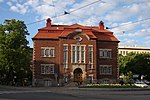Kallio

Kallio (Finnish: [ˈkɑlːio]; Swedish: Berghäll; literally "the rock") is a district and a neighbourhood in Helsinki, the capital of Finland, located on the eastern side of the Helsinki peninsula about one kilometre north from the city centre. It is one of the most densely populated areas in Finland. Kallio is separated from the city centre by the Siltasaarensalmi strait, over which is a bridge called Pitkäsilta ("long bridge"). Traditionally, the bridge symbolizes the divide between the affluent centre and the more working class areas around Kallio. After the forming of the new centre in the 19th century, the city expanded northward. The intense industrialization which began in the 1860s in Helsinki saw the construction of the industrial areas around Sörnäinen harbour and to the workers' district of Kallio, with the area becoming inhabited mostly by factory workers. However, most of the working-class families have long ago been replaced as the most typical Kallio residents by young adults and elderly people living alone, in a process which could be seen as some sort of gentrification. For many people who move into Helsinki from elsewhere in Finland, Kallio is the area where they first settle. Most flats are small, and rents are typically lower than elsewhere in central Helsinki, partly explaining the area's popularity among students and artists. The small flat sizes also mean that Kallio is expected to resist full gentrification. However, the rents have increased as the district has grown more popular and become an increasingly desirable area to live in. Kallio (and Harju, which is often considered a part of Kallio) also has, more than any other district in Helsinki, a reputation as a "bohemian" and liberal area. The area has a heterogeneous population and many bars. The area also has a number of sex shops, strip clubs and massage parlors. President Tarja Halonen was born in Kallio and lived there until she was elected president in 2000.
Excerpt from the Wikipedia article Kallio (License: CC BY-SA 3.0, Authors, Images).Kallio
Itäinen Papinkatu, Helsinki Kallio (Central major district)
Geographical coordinates (GPS) Address Website Nearby Places Show on map
Geographical coordinates (GPS)
| Latitude | Longitude |
|---|---|
| N 60.184166666667 ° | E 24.949166666667 ° |
Address
Kallion kirkko
Itäinen Papinkatu 2
00530 Helsinki, Kallio (Central major district)
Finland
Open on Google Maps











